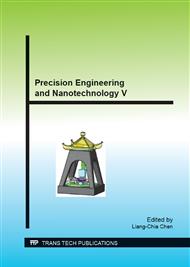p.587
p.593
p.597
p.603
p.607
p.615
p.621
p.627
p.633
Ultrasonically Assisted Micro Drilling for Acrylic Resin μ-TAS
Abstract:
Recently, technologies for medical inspection have been increasing rapidly. In biomedical industry, a demand of Micro Total Analysis System (μ-TAS) has been growing which used in automatically inspection for chemical analysis. The μ-TAS have micro passageway which is constructed by many fine micro holes. Final polishing by skilled workers are carried out after drilling to obtain smooth surface of holes. Because new manufacturing technique is required instead of skilled workers, it increases productivity and cost performance of the μ-TAS. Drilling technique with low temperature environment around cutting edge is required to prevent heat crack or adhesion on holes surface, because acrylic resin heats sensitive material. In this study, ultrasonically assisted micro drilling technique is proposed to increase productivity of μ-TAS and quality of micro holes. Ultrasonically assisted machining has effective technique to improve machinability, e.g. reduce cutting force, increase chip removability and machined surface quality. This paper describes the cutting characteristics of ultrasonically assisted micro-drilling for acrylic resin to employ the μ-TAS manufacturing to solve above problems.
Info:
Periodical:
Pages:
607-612
Citation:
Online since:
August 2014
Authors:
Keywords:
Price:
Сopyright:
© 2015 Trans Tech Publications Ltd. All Rights Reserved
Share:
Citation:


